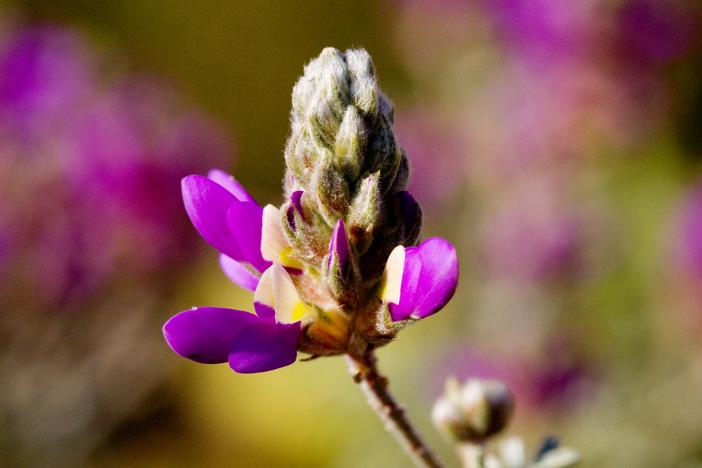Silver Prairie Clover
(Dalea bicolor)
Silver Prairie Clover (Dalea bicolor)
/
/

Patrick Alexander
CC0
Image By:
Patrick Alexander
Recorded By:
Copyright:
CC0
Copyright Notice:
Photo by: Patrick Alexander | License Type: CC0 | License URL: http://creativecommons.org/publicdomain/zero/1.0/deed.en | Uploader: Josve05a | Publisher: Wikipedia Commons














Estimated Native Range
Summary
Dalea bicolor, commonly known as Silver Prairie Clover, is an evergreen perennial subshrub native to arid and semi-arid regions including desert scrub, grasslands, and open woodlands in Mexico and the Southwestern United States. It typically grows to a height of 6-8 feet (1.8-2.4 meters) and a width of 5-6 feet (1.5-1.8 meters). This plant is characterized by its silvery-green foliage and its bicolored inflorescences, which feature a striking combination of red and purple flowers that bloom in the late summer to fall. The flowers are quite showy and attract pollinators such as bees and butterflies.
Silver Prairie Clover is valued for its drought tolerance and ability to thrive in harsh conditions, making it an excellent choice for xeriscaping and low-water-use gardens. It is also used for erosion control and as an ornamental in rock gardens and naturalized areas. In cultivation, it requires minimal maintenance, preferring full sun exposure and well-drained soils. While it tolerates a range of soil types, it performs best in soils with medium drainage. It is not commonly afflicted by diseases or pests, but overwatering can lead to root rot. Silver Prairie Clover is not known for aggressive roots or significant invasiveness, but it should be planted with care in small spaces due to its size.CC BY-SA 4.0
Silver Prairie Clover is valued for its drought tolerance and ability to thrive in harsh conditions, making it an excellent choice for xeriscaping and low-water-use gardens. It is also used for erosion control and as an ornamental in rock gardens and naturalized areas. In cultivation, it requires minimal maintenance, preferring full sun exposure and well-drained soils. While it tolerates a range of soil types, it performs best in soils with medium drainage. It is not commonly afflicted by diseases or pests, but overwatering can lead to root rot. Silver Prairie Clover is not known for aggressive roots or significant invasiveness, but it should be planted with care in small spaces due to its size.CC BY-SA 4.0
Plant Description
- Plant Type: Shrub
- Height: 6-8 feet
- Width: 5-6 feet
- Growth Rate: Moderate
- Flower Color: Purple, Red
- Flowering Season: Fall
- Leaf Retention: Evergreen
Growth Requirements
- Sun: Full Sun
- Water: Low
- Drainage: Medium
Common Uses
Bee Garden, Bird Garden, Butterfly Garden, Drought Tolerant, Fragrant, Low Maintenance
Natural Habitat
Arid and semi-arid regions including desert scrub, grasslands, and open woodlands
Other Names
Common Names: Silver Prairie-Clover , Carnero
Scientific Names: Dalea bicolor , Dalea seemanni , Dalea megalostachys , Dalea seemannii subsp. seemannii , Dalea argyraea , Parosela megalostachys , Parosela bicolor , Parosela longiracemosa
GBIF Accepted Name: Dalea bicolor Humb. & Bonpl. ex Willd.